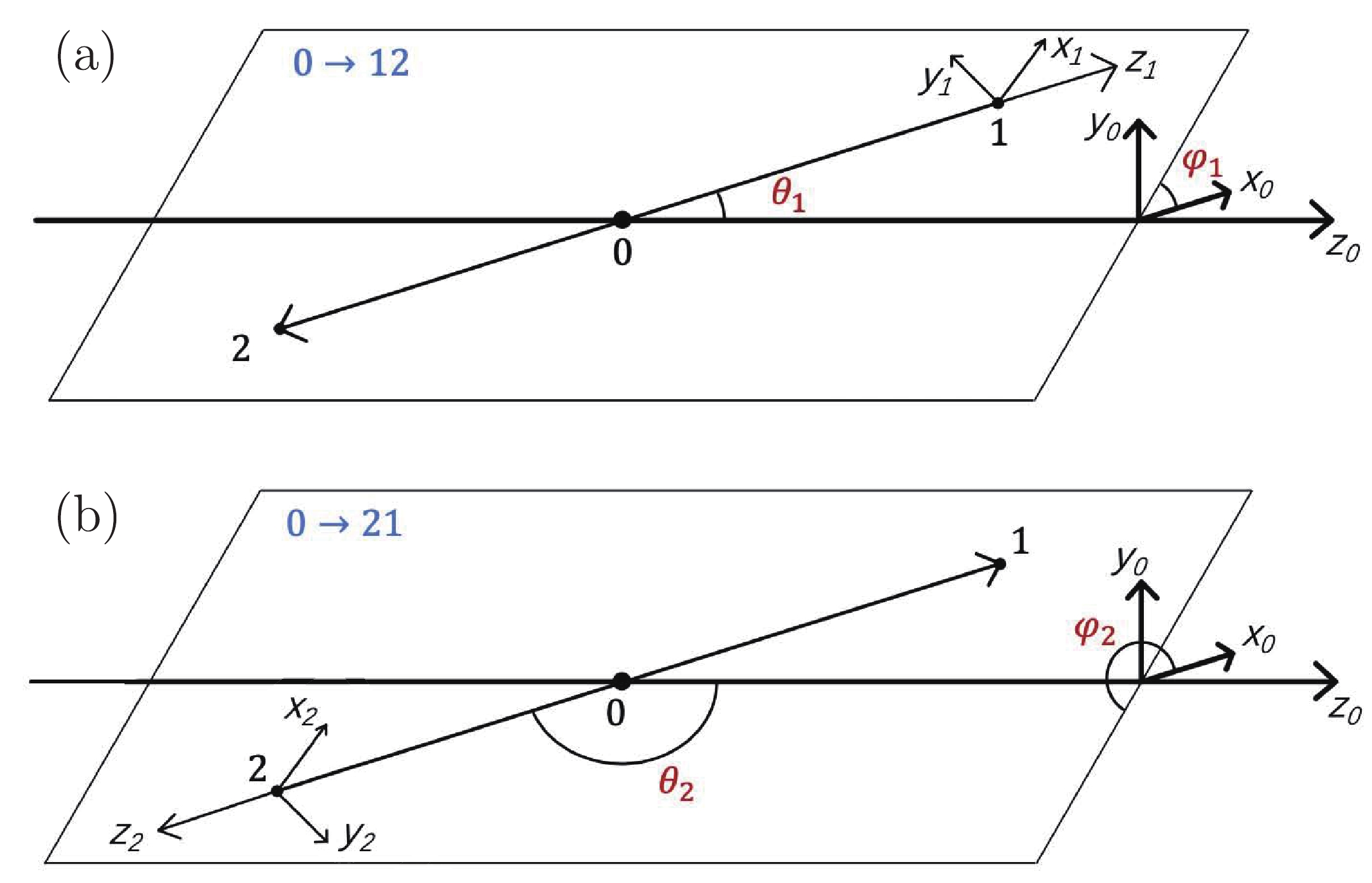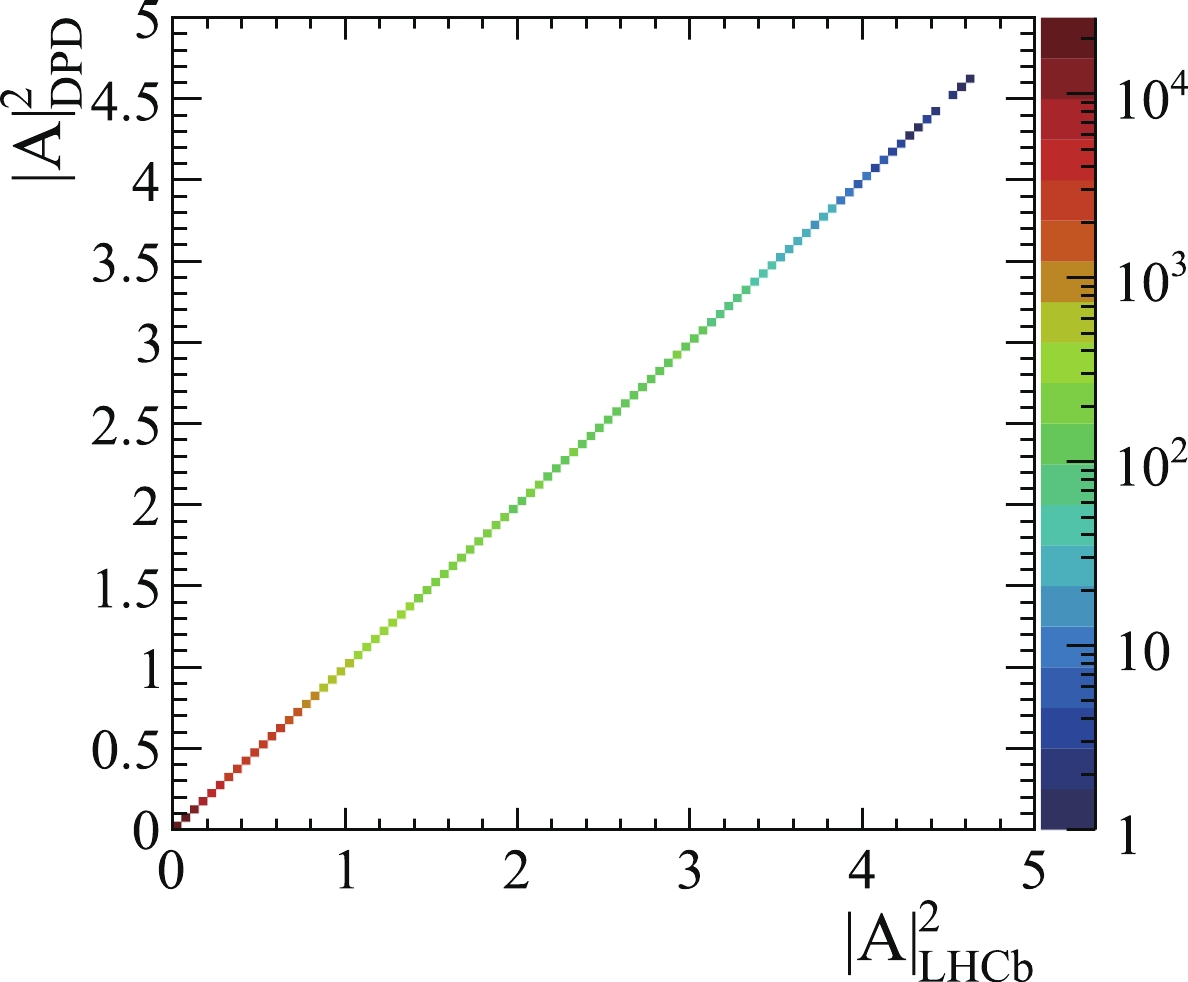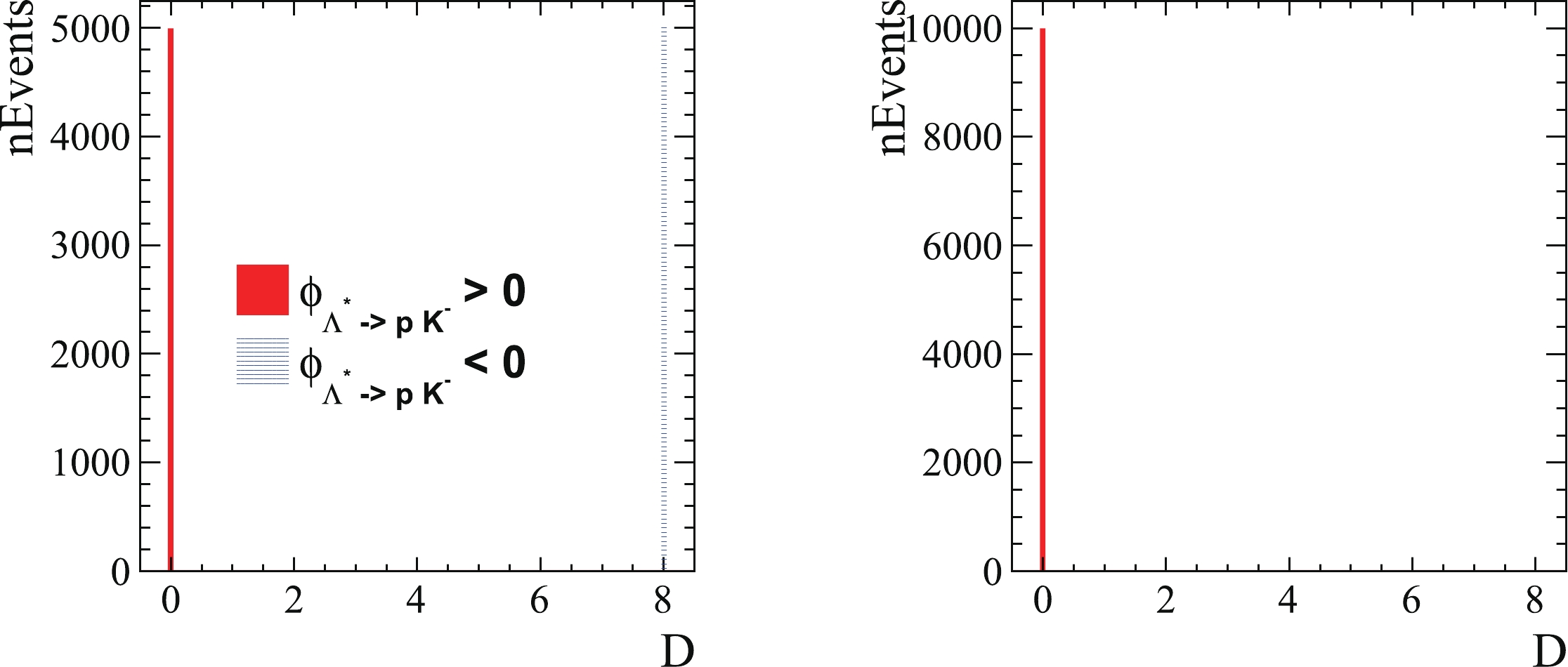HTML
--> --> -->Helicity formalism was used in the amplitude analysis of the
The remainder of this paper is organized as follows. Sec. II briefly introduces puzzles in the standard helicity formalism and the influence on the decay amplitude. Sec. III proposes a systematic method based on the final-state alignment of different chains to derive the correct helicity amplitude. Sec. IV presents an example use case of the
$ A_{0\to12}(m_0, \theta_1, \phi_1) = H^{0\to12}_{\lambda_1, \lambda_2} D^{J_0}_{\lambda_0, \lambda_1-\lambda_2} (\phi_1, \theta_1, 0) R(m_0), $  | (1) |
 Figure1. (color online) Helicity angles of
Figure1. (color online) Helicity angles of The total amplitude of the
2
A.Particle ordering issue
In standard helicity formalism, in principle, there is no preference regarding the selection of the reference particles. For the $ D^{J_0}_{\lambda_0, \lambda_1-\lambda_2}(\phi_1, \theta_1, 0) = (-1)^{J_0+\lambda_0 \pm \lambda_0} D^{J_0}_{\lambda_0, \lambda_2-\lambda_1}(\phi_2, \theta_2, 0) , $  | (2) |
As an example, for the
| Ordering 1 | Ordering 2 | |
  |   |   |
  |   | p |
  |   |   |
  |   |   |
Table1.Selection of reference particles for each two-body decay involved in
The contributions of the estimated interference term between the amplitudes of the
 Figure2. Contribution from interference term between
Figure2. Contribution from interference term between In the DPD formula [3], the
 Figure3. (color online) Two-dimensional distributions of amplitude module square of simulated
Figure3. (color online) Two-dimensional distributions of amplitude module square of simulated 2
B.Particle-two factor issue
In the DPD paper [3], the “Jacob-Wick particle-2 phase convention” was discussed, which was introduced in Ref. [6] and enables natural matching of the particle-2 helicity states to the canonical basis. In this section, the particle-2 phase convention is explained in an alternative method by introducing a “particle-two factor” to describe the transition of the spin axis appropriately. We also demonstrate that one must explicitly consider the particle-two phase factor to preserve the customary parity conservation relations, $ H^{0\to12}_{-\lambda_1, -\lambda_2} = P_0 P_1 P_2 (-1)^{J_1 + J_2 - J_0} H^{0\to12}_{\lambda_1, \lambda_2}, $  | (3) |
The rotation operator indicated in Eq. (1) results in a spin axis along the same direction as the momentum of particle 1. However, to consider the further decay of particle 2, the commonly used initial spin axis is along the momentum direction of particle 2, which requires an additional term between the amplitudes of the
To obtain the exact form of the particle-two factor, we define a Cartesian coordinate system
The most natural choice of the rotation axis is the
$ <J_2, -\lambda_2|R_x(\pi)|J_2, \lambda_2> = (-1)^{J_2}, $  | (4) |
$ <J_2, -\lambda_2|R_y(\pi)|J_2, \lambda_2> = d_{-\lambda_2, \lambda_2}^{J_2} = (-1)^{J_2 - \lambda_2}, $  | (5) |
The particle-two factor is important for associating the helicity couplings and their
If the further decay of particle 2 is not considered in the amplitude analysis, we suggest also adding the particle-two factor after the
In the
The goal of the spin-axis alignment is to ensure that the combined
$ R_{{\rm{Euler}}, \Lambda^*} = B_{ P_c} B^{-1}_{ \Lambda^*} R_{{\rm{align}}, P_c} R_{{\rm{Euler}}, P_c} \;, $  | (6) |
Once the particle ordering has been determined, the decay angles of all of the two-body decays can be calculated [1,2], based on which
As all of the angles in Eq. (6) are directly obtained from the decay amplitude, it should be sensitive to the switching of the reference particles and should generate a visible effect once a proper representation is assigned to the rotation operators. For the
$ {R_z}(\alpha ) = \left( {\begin{array}{*{20}{c}}{{{\rm e}^{-{\rm i}\alpha /2}}}&0\\0&{{{\rm e}^{{\rm i}\alpha /2}}}\end{array}} \right),$  | (7) |
$ {R_y}(\alpha ) = \left( {\begin{array}{*{20}{c}}{\cos (\alpha /2)}&{ - \sin (\alpha /2)}\\{\sin (\alpha /2)}&{\cos (\alpha /2)}\end{array}} \right), $  | (8) |
$ R(\alpha, \vec{a}) = R_z(\phi_a)R_y(\theta_a)R_z(\alpha)R_y(-\theta_a)R_z(-\phi_a), $  | (9) |
$ {B_z}(\gamma ) = \left( {\begin{array}{*{20}{c}} {{{\rm e}^{ - \gamma /2}}}&0\\ 0&{{{\rm e}^{\gamma /2}}} \end{array}} \right), $  | (10) |
$ B(\gamma, \vec{b}) = R_z(\phi_b)R_y(\theta_b)B_z(\gamma)R_y(-\theta_b)R_z(-\phi_b), $  | (11) |
2
A.Rotations when using ordering 1
If ordering 1 is used, the corresponding proton-related Euler rotation for the $ \begin{aligned}[b] R_{{\rm{Euler}}, \Lambda^*} =& R(\pi, \vec{p}_{\Lambda^*}^{\Lambda_b^0} \times \vec{p}_{K}^{\Lambda^*}) R(\theta_{\Lambda^*}, \vec{p}_{\Lambda^*}^{\Lambda_b^0} \times \vec{p}_{K}^{\Lambda^*}) \\&\times R(\phi_K, \vec{p}_{\Lambda^*}^{\Lambda_b^0}) R(\theta_{\Lambda_b^0}, \vec{p}_{\Lambda^*}^{\Lambda_b^0} \times \vec{p}_{\Lambda_b^0}^{lab}) R(\phi_{\Lambda^*}, \vec{p}_{\Lambda_b^0}^{lab}) , \end{aligned} $  | (12) |
$ \begin{aligned}[b] R_{{\rm{Euler}}, {P}_{\rm{c}}} =& R(\pi, \vec{p}_{\psi}^{P_c} \times \vec{p}_{K}^{P_c}) R(\theta_{P_c}, \vec{p}_{\psi}^{P_c} \times \vec{p}_{K}^{P_c}) \\&\times R(\phi_\psi^{P_c}, \vec{p}_{P_c}^{\Lambda_b^0}) R(\theta_{\Lambda_b^0}^{P_c}, \vec{p}_{P_c}^{\Lambda_b^0} \times \vec{p}_{\Lambda_b^0}^{lab}) R(\phi_{P_c}, \vec{p}_{\Lambda_b^0}^{lab}), \end{aligned} $  | (13) |
$ R_{{\rm{align}}, {\rm{P}}_{\rm{c}}} = R(\pi, \vec{p}_{K}^{\Lambda^*}) R(\theta_p, \vec{p}_{\psi}^{P_c} \times \vec{p}_{K}^{P_c}), $  | (14) |
2
B.Rotations when using ordering 2
If ordering 2 is used, the Euler rotation for the $ \begin{aligned}[b] R_{{\rm{Euler}}, \Lambda^*} =& R(\theta_{\Lambda^*}, \vec{p}_{\Lambda^*}^{\Lambda_b^0} \times \vec{p}_{p}^{\Lambda^*}) R(\phi_p, \vec{p}_{\Lambda^*}^{\Lambda_b^0})\\&\times R(\theta_{\Lambda_b^0}, \vec{p}_{\Lambda^*}^{\Lambda_b^0} \times \vec{p}_{\Lambda_b^0}^{lab})R(\phi_{\Lambda^*}, \vec{p}_{\Lambda_b^0}^{lab}). \end{aligned} $  | (15) |
$ \begin{aligned}[b] R_{{\rm{Euler}}, {P}_{\rm{c}}} =& R(\pi, \vec{p}_{\psi}^{P_c} \times \vec{p}_{K}^{P_c}) R(\theta_{P_c}, \vec{p}_{\psi}^{P_c} \times \vec{p}_{K}^{P_c}) \\&\times R(\phi_\psi^{P_c}, \vec{p}_{P_c}^{\Lambda_b^0}) R(\theta_{\Lambda_b^0}^{P_c}, \vec{p}_{P_c}^{\Lambda_b^0} \times \vec{p}_{\Lambda_b^0}^{lab}) R(\phi_{P_c}, \vec{p}_{\Lambda_b^0}^{lab}), \end{aligned} $  | (16) |
$ R_{{\rm{align}}, {P}_{\rm{c}}} = R(\theta_p, \vec{p}_{\psi}^{P_c} \times \vec{p}_{K}^{P_c}). $  | (17) |
2
C.Boost operators
The boost operators are defined in the same manner for both ordering 1 and ordering 2. The operator $ B_{ \Lambda^*} = B(-y_{p}^{\Lambda^*}, \vec{p}_{p}^{\Lambda^*}) B(-y_{\Lambda^*}^{\Lambda_b^0}, \vec{p}_{\Lambda^*}^{\Lambda_b^0}), $  | (18) |
$ y = \frac{1}{2} \ln \left(\frac{E_a+p_a}{E_a-p_a}\right), $  | (19) |
$ B_{P_{\rm{c}}} = B(-y_{p}^{P_c}, \vec{p}_{p}^{P_c}) B(-y_{P_c}^{\Lambda_b^0}, \vec{p}_{P_c}^{\Lambda_b^0}), $  | (20) |
2
D.Validation of alignment equation
For improved visibility of the validation of Eq. (6), the distance between the matrices on its left and right sides is defined as $ D = \sum\limits_{i,j} | L_{i,j}-R_{i,j}|^2 , $  | (21) |
 Figure4. (color online) Distribution of D determined with helicity and alignment angles obtained using method proposed in Ref. [2]. The figure on the left is obtained based on ordering 1, where half of the candidates have perfect alignment between the two chains, whereas
Figure4. (color online) Distribution of D determined with helicity and alignment angles obtained using method proposed in Ref. [2]. The figure on the left is obtained based on ordering 1, where half of the candidates have perfect alignment between the two chains, whereas For decays with more than three final-state particles, the alignment rotation obtained from Eq. (6) may be more complicated, and it needs to be expressed using both the polar and azimuthal angles. The rotation matrix should be transformed into the Euler style under a corresponding Cartesian coordinate system, which makes it easier to obtain the correct alignment term in the decay amplitude. Taking Fig. 1 as an example, consider the alignment of particle 1. The Euler angles should be calculated in the
$ R_{z_1}(\alpha) R_{y_1}(\beta) R_{z_1}(\gamma), $  | (22) |
$ R_{z_1}(\alpha) R_{y_1}(\beta) R_{z_1}(\gamma) = R_{{\rm{Euler}}, {\rm{trans}}} R_{z}(\alpha) R_{y}(\beta) R_{z}(\gamma) R^{-1}_{{\rm{Euler}}, {\rm{trans}}} $  | (23) |
$ {R_z}(\alpha ){R_y}(\beta ){R_z}(\gamma ) = \left( {\begin{array}{*{20}{c}}\!\!\!\!{{{\rm e}^{-{\rm i}(\alpha + \gamma )/2}}\cos (\beta /2)}&{ - {{\rm e}^{-{\rm i}(\alpha - \gamma )/2}}\sin (\beta /2)}\!\!\!\!\\\!\!\!\!{{{\rm e}^{{\rm i}(\alpha - \gamma )/2}}\sin (\beta /2)}&{{{\rm e}^{{\rm i}(\alpha + \gamma )/2}}\cos (\beta /2)}\!\!\!\!\end{array}} \right).$  | (24) |
$ {R_{{\rm{Euler}}}} = \left( {\begin{array}{*{20}{c}}a&b\\c&d\end{array}} \right), $  | (25) |
$ R_{{\rm{Euler}},{\rm{trans}}}^{ - 1}{R_{{\rm{Euler}}}}{R_{{\rm{Euler}},{\rm{trans}}}} = \left( {\begin{array}{*{20}{c}}{a'}&{b'}\\{c'}&{d'}\end{array}} \right),$  | (26) |
$ \begin{aligned}[b] \cos(\beta/2) =& |a'| , \sin(\beta/2) = |b'|, \\ \alpha+\gamma =& -2{\rm{Arg}}(a'), \\ \alpha-\gamma =& 2{\rm{Arg}}(c'). \end{aligned}$  | (27) |
If ordering 2 is used, the modifications are as follows:
● For the
● Add the particle-two factors in the decay amplitude, including the term of
If ordering 1 is used, the modifications are as follows:
● For events with
● The operator
In this study, we first demonstrated the necessity of carefully considering the particle ordering issue, particularly for decays involving spin-half-integral particles, where the selection of the reference particles has a non-negligible influence on the interference term. Thereafter, we proposed a new technique to validate whether the decay amplitude is expressed correctly under a dedicated particle ordering. This technique verifies whether the rotation operators involved in different decay chains properly align the spin axes of the final-state particles. A dedicated representation for the operators has been proposed, which can aid experimentalists in conducting event-by-event checking of the final-state alignment in a numerical manner. Using this new technique, a proper final-state alignment can be achieved with any given particle orderings, and the inconsistency between different orderings can be cancelled by assigning different alignment rotation operators. Numerical calculations using the simulated
